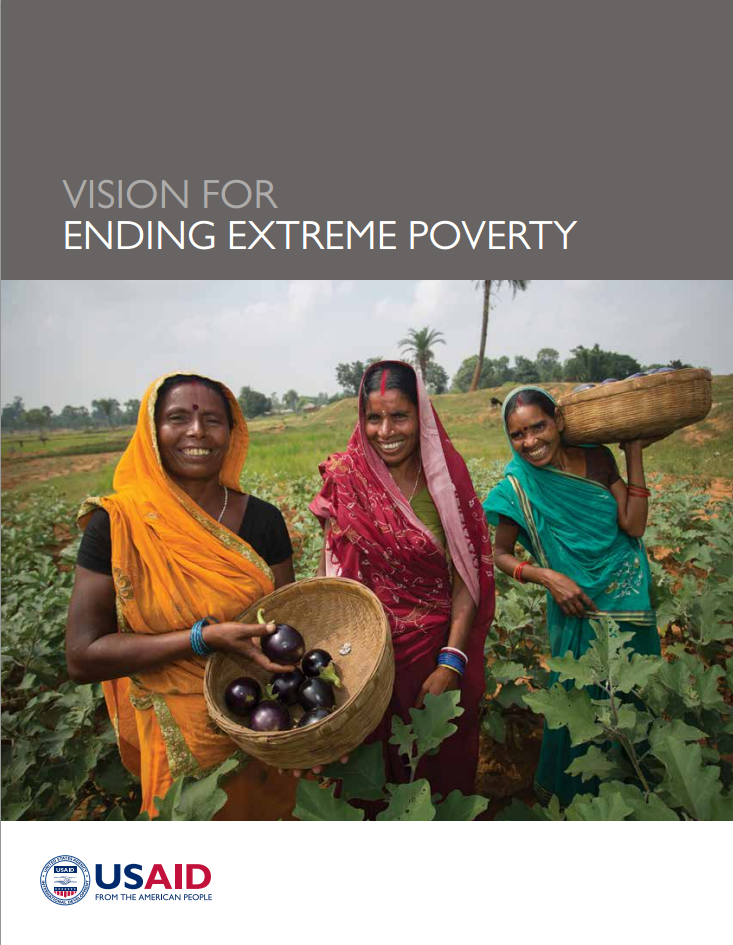- What We Do
- Agriculture and Food Security
- Democracy, Human Rights and Governance
- Economic Growth and Trade
- Education
- Ending Extreme Poverty
- Environment and Global Climate Change
- Gender Equality and Women's Empowerment
- Global Health
- Water and Sanitation
- Working in Crises and Conflict
- U.S. Global Development Lab
Vision for Ending Extreme Poverty ![]() (pdf - 11 MB)
(pdf - 11 MB)
A Call to Action
The United States is helping to lead a concerted, international effort to end extreme poverty. Success will depend, foremost, on the actions of governments and citizens in the countries that are home to the world’s extreme poor. USAID, as the U.S. Government’s lead development agency, will act as partner and catalyst to achieve this goal, which lies at the core of our mission statement: We partner to end extreme poverty and promote resilient, democratic societies while advancing our security and prosperity. USAID’s vision for ending extreme poverty frames our role in this collective effort. It lays out our definition of extreme poverty; our understanding of what has driven progress; an analysis of pertinent trends and challenges; and a strategic framework for USAID’s approach. This vision is not a new initiative—but rather an opportunity to sharpen our enduring commitment to sustainable, inclusive development that reduces extreme poverty in all its forms. By seizing this opportunity together with our partners in the U.S. government, we will advance U.S. leadership on this global priority and enhance U.S. national security.
Defining Extreme Poverty
Extreme poverty is the inability to meet basic consumption needs on a sustainable basis. The persistence of extreme poverty is a complex and multidimensional phenomenon. People who live in extreme poverty lack both income and assets and typically suffer from interrelated, chronic deprivations, including hunger and malnutrition, poor health, limited education and marginalization or exclusion. Women and girls in particular face distinct challenges. The extreme poor often face discrimination, marginalization or exclusion and are vulnerable to falling further into extreme poverty, lacking the resilience to cope with economic setbacks, natural disasters or illnesses.
A Theory of Change for Ending Extreme Poverty
The development record is clear: The driver of extreme poverty reduction is inclusive economic growth supported by a foundation of effective governance and accountable institutions. Each country’s path is unique, but there are commonalities across success stories. Economic growth spreads through dynamic, vibrant and open markets; it thrives on investments in people’s capacity and human capital; it relies on modern infrastructure; it flourishes in peaceful and just societies; and it both benefits from and contributes to strong, reliable safety nets. Local ownership and political will are paramount. Growth itself must be sustainable and cannot rely on the destruction of environmental assets as the extreme poor often rely heavily upon irreplaceable natural resources.
The Current and Future Development Context
The eradication of extreme poverty within a generation is feasible—but it is far from guaranteed. Projections of economic growth are highly uncertain, but unless growth is both rapid and inclusive, extreme poverty is likely to persist in today’s poorest countries, many of which are in sub-Saharan Africa. A significant number of vulnerable people also remain in Asia, and pockets of extreme poverty continue to exist in all regions, even in countries that have grown into middle-income status. There are daunting challenges associated with conflict and fragility and with climate change, and the implications of urbanization may vary sharply across countries. Emerging opportunities lie in evolving sources and mechanisms of development finance, including greater attention to domestic resource mobilization; youth bulges that can provide a demographic dividend if supportive social and economic policies are in place; and the transformative potential of data and technology. These global trends will shape individual country trajectories; USAID’s task is to help push these trajectories toward their most promising possibilities.
A Moment of Opportunity
USAID is sharpening its focus on ending extreme poverty by integrating this overarching objective into policy, planning and programming. We have developed analytical tools, conducted case studies, hosted learning events and incorporated this priority into selected Country Development Cooperation Strategies. USAID will continue to build on this momentum around four lines of effort:
- issuing operational guidance on integrating extreme poverty into the Program Cycle;
- tailoring our analytic tools to Mission needs to embed a greater focus on extreme poverty;
- rigorously measuring and evaluating the effects of our extreme poverty-reducing programs; and
- planning strategically to create the flexibility to focus resources where extreme poverty persists.
In the short term, we will exploit opportunities to enhance the impact of existing resources and programming in reducing extreme poverty. This ensures a strong, focused and clear commitment within existing budget limitations and relevant program areas. Over the longer term, USAID will focus even further on countries where extreme poverty is likely to persist and on challenges where we are most likely to make an impact. We will continue to work with developing country governments, civil society, other donors, local actors and the private sector to define the most effective approaches. This does not simply mean targeting pockets of extreme poverty or limiting our engagement to very poor countries; in line with a systems approach, it involves much more than the direct provision of assistance to the extreme poor. As we join with our partners to achieve the 2030 Agenda for Sustainable Development, our Vision for Ending Extreme Poverty sets a strategic direction for the Agency. It does not provide all of the answers, but by better understanding how we can more effectively contribute to this goal, we can move forward with a new clarity of vision.








Comment
Make a general inquiry or suggest an improvement.